In North Dakota, it is possible to spot 9 different species of Hawks. These are:
- Red-Tailed Hawk
- Northern Harrier
- Ferruginous Hawk
- Swainson’s Hawk
- Sharp-shinned Hawk
- Cooper’s Hawk
- Northern Goshawk
- Rough-legged Hawk
- Broad-winged Hawk
Want to learn more? This book on the Birds of Prey of North America is a fantastic read!
North Dakota is one of America’s most pristine natural aviaries, residing in the northwestern part of the country where undisturbed forests are abundant.
While Canada remains a prominent breeding ground for many birds-of-prey who follow the food, North Dakota’s proximity to the border makes it an ideal location for independent raptors to spread their wings.
This list concentrates on hawks, explaining which ones call North Dakota home and how to spot them.
Want to attract birds of prey to your yard? Take a look at our article!
What Hawks can be seen in North Dakota?
1. Red-Tailed Hawk
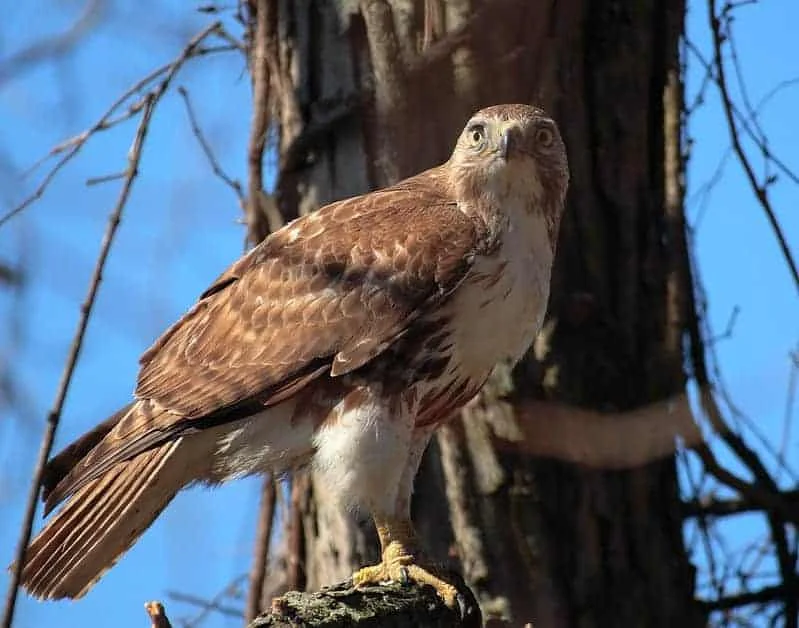
As it is the most abundant hawk in North America, this Canadian breeder probably feels right at home in the crisp air and tall forests of North Dakota. It can be spotted by the trademark ‘red’ feathers on its tail, most prominently displayed as it takes flight or swoops down from a perch to hunt.
Elsewhere, red-tails have the typical morphs of most of their kind which vary between shades of brown on the rear and crown, and white undersides speckled with lighter varieties of that same color throughout.
They are also among the largest hawks in North America, in both bulk and wingspan, granting them a somewhat more fearsome appearance than their smaller kin.
Red-tails are likely the inspiration for the term ‘roadside raptor’ as they are encountered hunting next to the open roads between towns, and will even perch on road signs to stare at the infrequent traffic.
National Parks like Theodore Roosevelt’s are good places to get lucky if you can get to some of the more remote places safely.
2. Northern Harrier
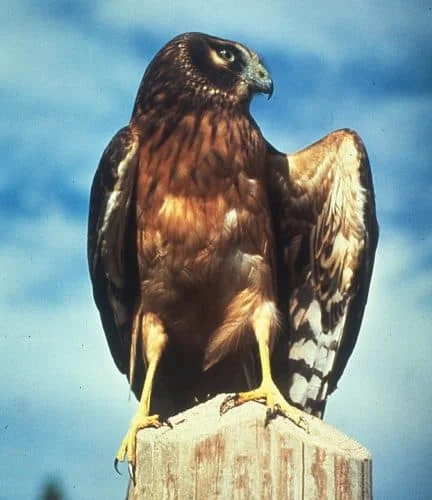
These hawks gather in the midwinter to the beginning of the next fall, nesting and hunting, and begin breeding in may throughout the summer.
The term ‘harrier’ refers to how the hawk hunts its prey. Unlike other hawks, who generally watch from a perch and swoop to take meals as they scatter, fly, or swim, the harrier remains airborne the entire time “harrying” its prey.
These birds are most known for their appearance, which is easily mistaken for an own with their round faces and the row of feathers outside it.
Harriers are a bit more sleek, a bit less round than owls, however, and their long tails are more like sparrows than most hawks. Look for white stomachs blended with either gray or brown that get darker on the rear wing and back.
They hunt in lowland plains, wetlands, and marshes where there is room to circle their meals.
3. Ferruginous Hawk
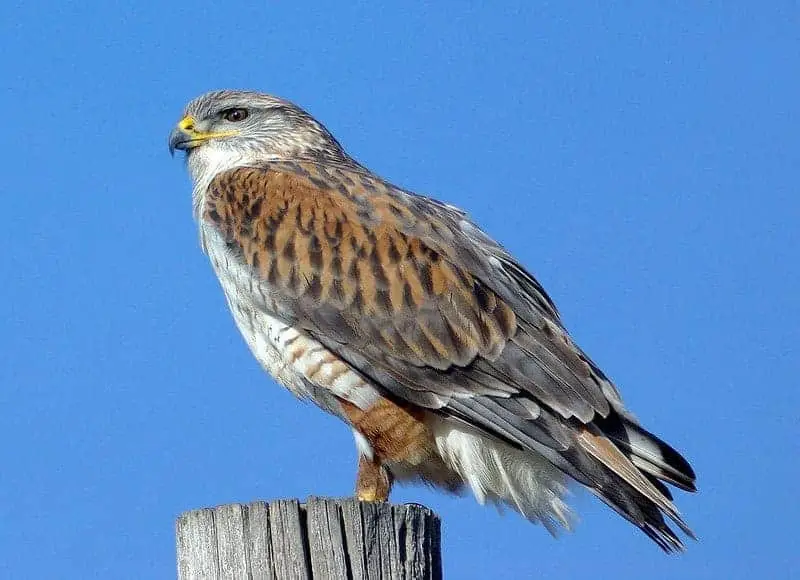
This large hawk occurs in North Dakota from early spring to mid-fall. It hunts in open areas like grassy plains and pastures like the harrier, except these places are always next to the edges of tall forests where the ferruginous hawk can wait for movement.
They have the regal profile of an eagle, with a stout body and a long, hooked beak, though a bit more compact. Colors are generally whitish in the underside of its wings and belly, with dark browns specked with lighter browns across the back and crown.
Males tend to be darker in the face and neck, where the females will have faces that match their bellies. These are solitary and nomadic birds who avoid human contact outside of the odd abandoned tower, and will move farther into the woods if neighborhoods encroach.
National Parks like Theodore Roosevelt are good bets, as are any foraging trove where squirrels and prairie dogs gather, since these are the hawk’s favorite targets.
4. Swainson’s Hawk
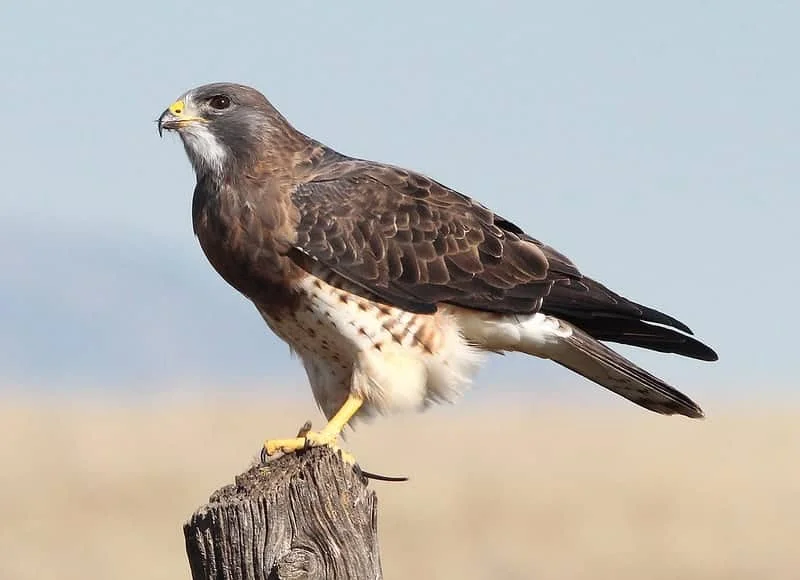
The common theme of grassland hunter’s among the raptors of North Dakota continues with this hawk, named for early American ornithologist William Swainson.
They are actually adaptable to most any environment, whether striking from on high at a plain bordering a treeline or snatching songbirds from mid-air. Its sleek appearance is perhaps the perfect hawk specimen, with enormous eyes compared to its head and bright yellow feet bearing barbed talons.
The basic coloring of a Swainson’s male is a white underbelly speckled with brown, a brown back and head, with a lighter brownish ‘collar’ encircling its neck.
Less often, there are morphs which are entirely dark brown. Females tend to be lighter, with some even mostly white with specks of brown. This raptor hunts small mammals like the ferruginous, and in similar fashion, using treeline perches to strike at low-lying grasslands, marshes, and wetlands.
5. Sharp-shinned Hawk
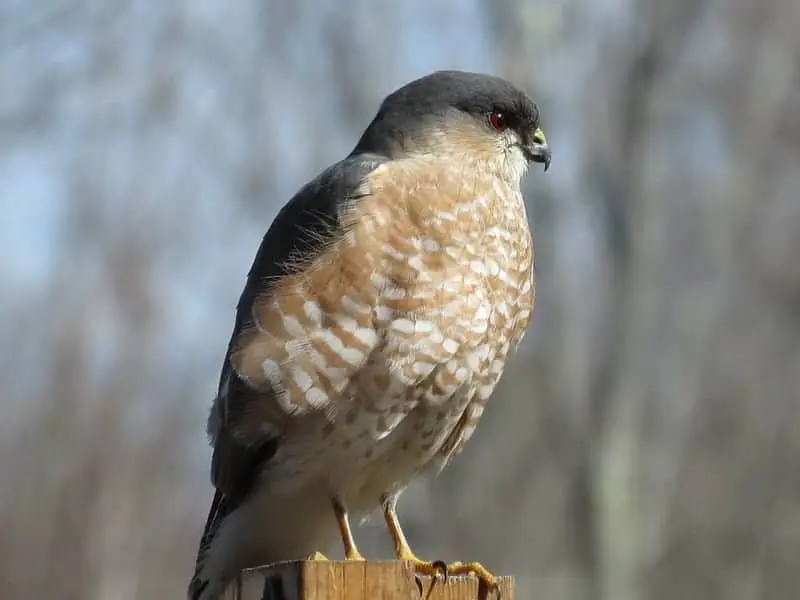
This aerial acrobat gets its namesake from the shape of its legs, which is common to most hawks but made more pronounced due to the length of this bird’s lower appendages.
They are just as likely to snatch prey from mid-air as they are from the ground, though catching them doing either is a tall task considering how fast they move.
Indeed, they make up for their relatively diminutive stature compared to other hawks with unrivaled flying skills, thanks to a sparrow-like body and a long tail that helps them fly between obstacles and snatch prey from the air.
They have blue-gray backs and crowns, with rose-colored faces that bleed into the offwhite feathers on their stomachs. Some less common morphs are all gray.
6. Cooper’s Hawk
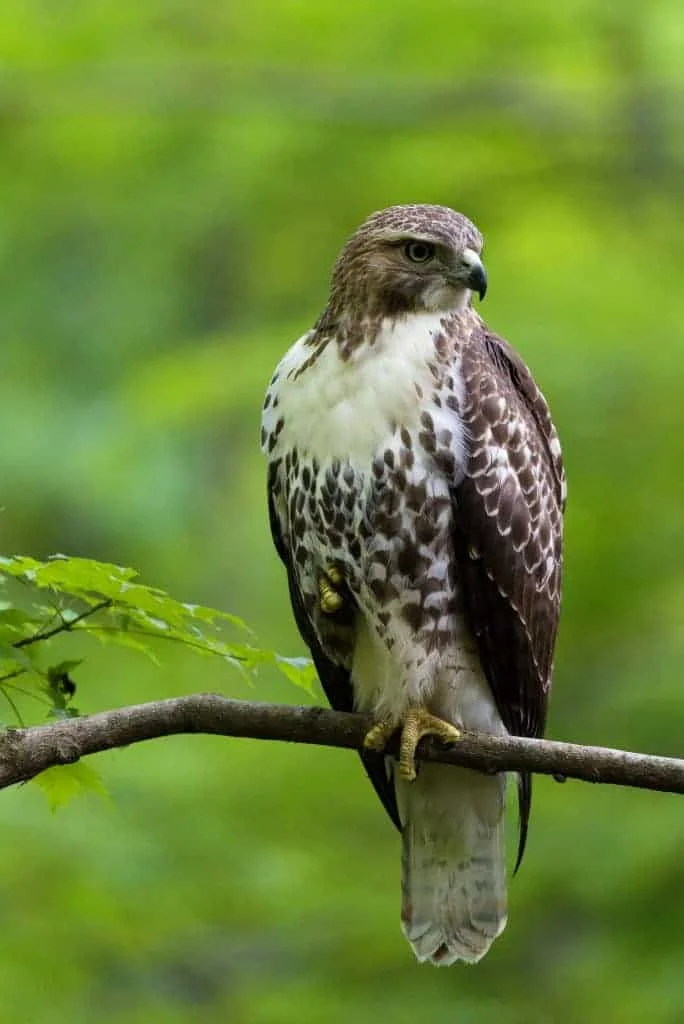
In North Dakota, Cooper’s hawk breeds and lives year-round near the Canadian, often traveling back and forth between countries as the season’s change.
With a blue-gray ‘coat’ atop white and brown blended belly and face, it can be easy to mistake this raptor for its sharp-shinned cousin, but they are nearly twice as heavy with 50% more wingspan.
In less common varieties, the grays are replaced with browns in similar patterns though with more brown about the face.
Cooper’s hunt from places hidden in the dense trees where they can catch unsuspecting prey, which includes mid-flight birds. Indeed, their nests are built throughout North Dakota, but Cooper’s stealthy nature makes spotting one of them a bit more of a task.
7. Northern Goshawk
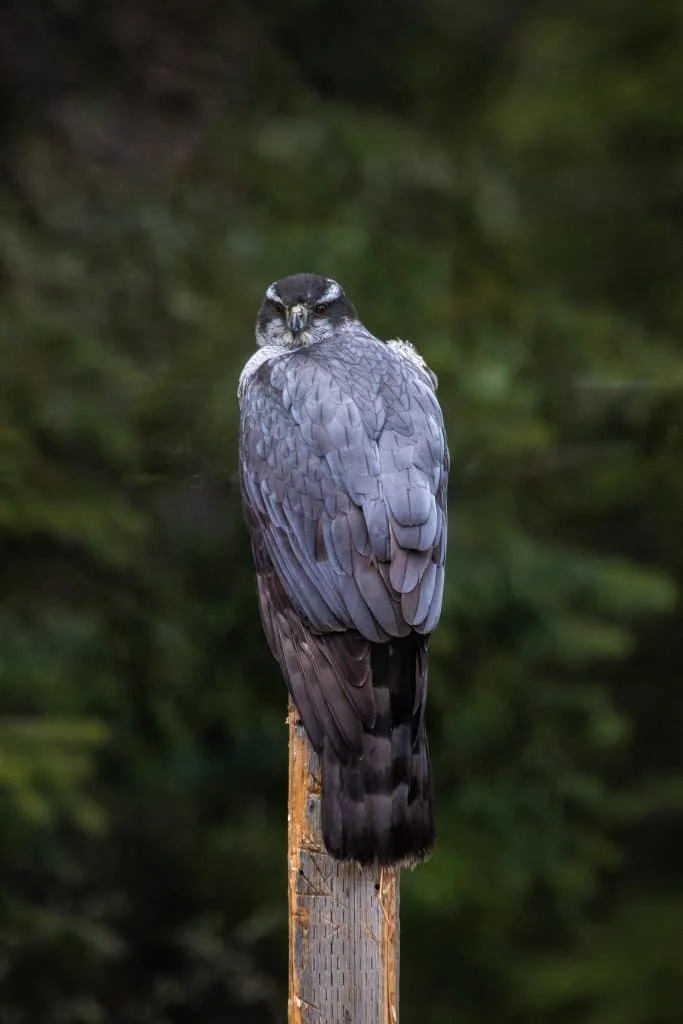
Like the Cooper’s, this hawk is a mainstay of Canada that leaks across the border to warm up and sometimes remain.
As its name indicates, though, the northern goshawk is more of a visitor to North Dakota than a resident.
Initial glances might reveal a coat that is white on the belly and face, and gray or brown on the backside and crown; closer inspection will show a mixture of specks and random patches of lighter feathers throughout.
Facial patterns may vary from the dark ‘bandits mask’ pattern about the eyes with a single white ‘brow’ across the top, to a solid brown or gray speckled with the same lighter shade as their stomachs.
Sightings may be limited to blurs moving among the trees, as this hunter can strike and leave the scene before even the most alert watcher notices.
8. Rough-legged Hawk
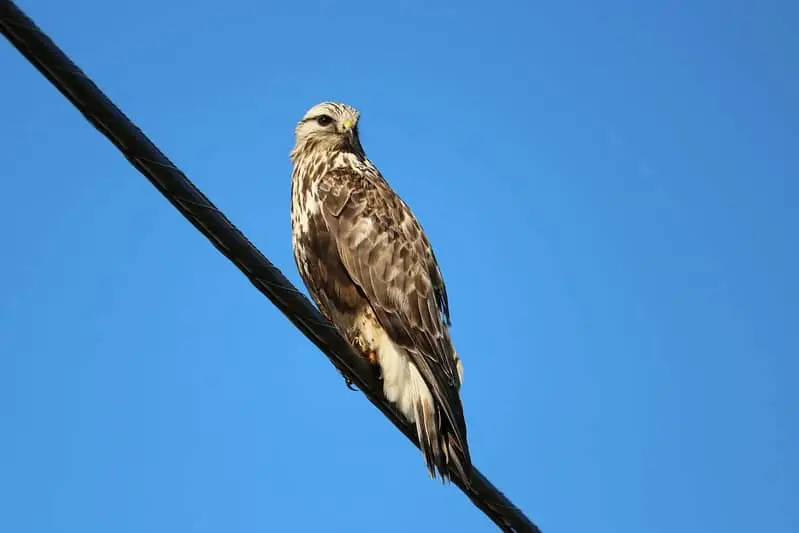
This hawk’s name comes from the extension of feathers that extrude from its body across its knees, giving its legs a ‘rough’ appearance.
Else, their color patterns offer much variation. Many morphs will appear to have a white base speckled with ranging shades of brown and a dark patch of brown across the stomach.
Others will appear the same, except with the colors inverted; that is, a predominantly brown body and wings speckled with white throughout instead.
This is an arctic bird that breeds at the far northern tip of Canada where ice reigns, but the rough-legged hawk still vacations south of the border when the temperatures are extreme.
They can be found in all forest types, hunting by circling about the ground like a harrier, but also from tall coniferous perches like most other hawks.
9. Broad-winged Hawk
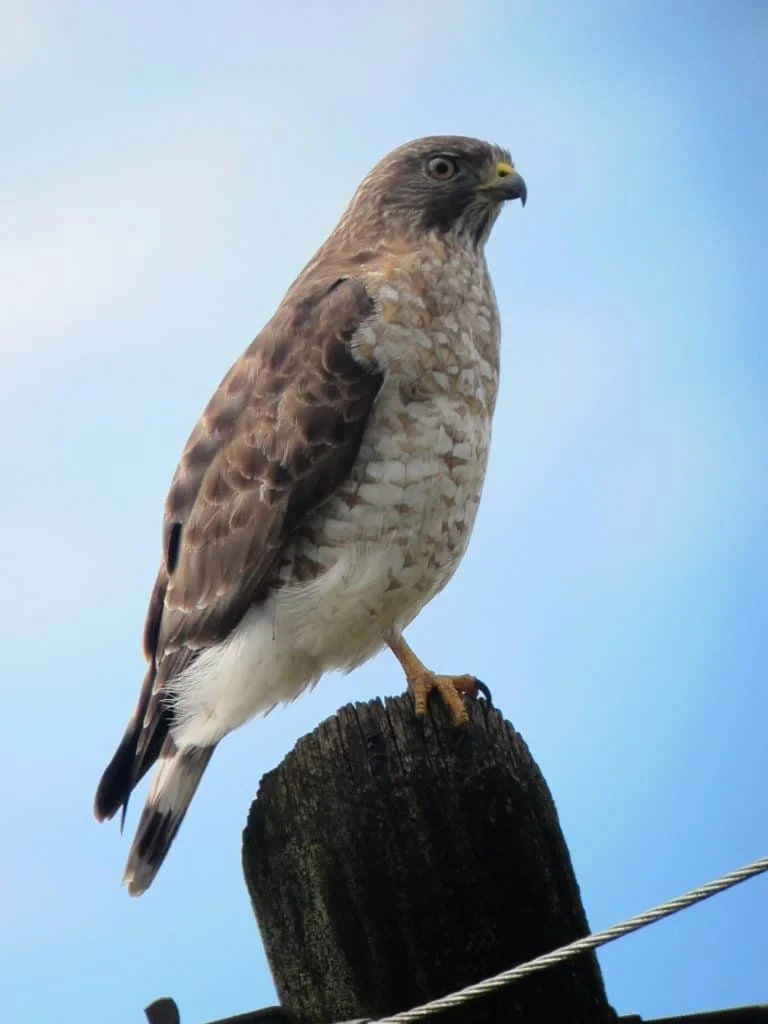
This bird’s identifier comes mostly when it’s in flight and we can appreciate its wingspan, which is more eagle-like than most of its kind in both length and width.
Its bulky frame is usually covered in brown feathers on the crown and rear with the hawk-typical white and brown speckled pattern on the stomach.
Face masks vary from dark colors that unify with the crown to form a single-colore head, or a continuation of the belly’s color, which is usually on off-white.
A prominent white stripe can also be seen on the underside of its tail, especially in flight. You may catch this hawk in winter nature reserves with enough patience.
References
https://gf.nd.gov/wildlife/id/raptors
https://www.audubon.org/field-guide/bird/red-tailed-hawk

About Us
We are avid bird-watchers who recently retired, allowing us more time to travel the world. Fortunately, we have managed to visit numerous countries around Europe, Asia, and America. Watching and photographing birds has been a passion for many years and we are making the most of the extra time on our hands!
